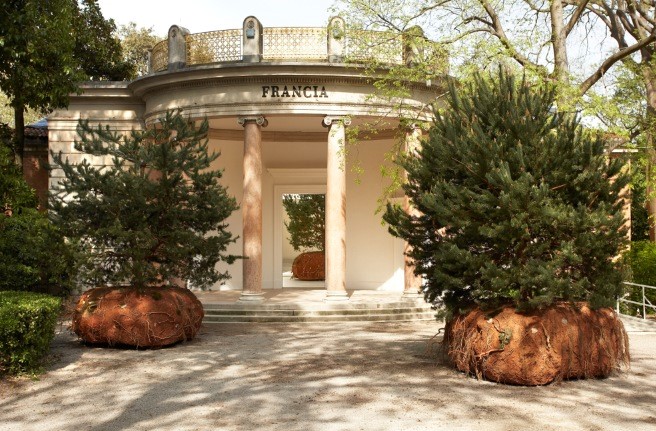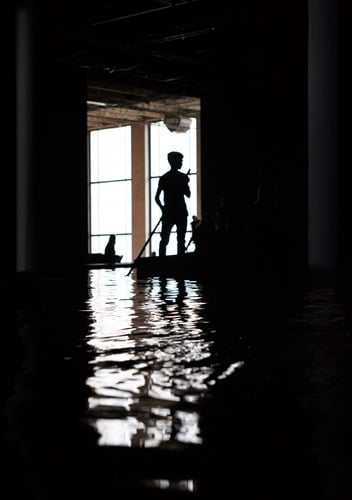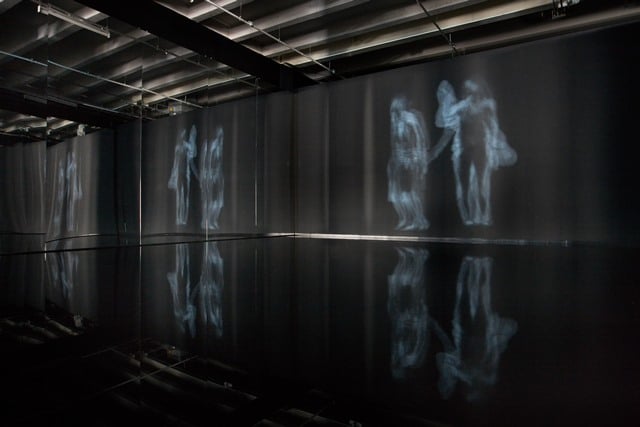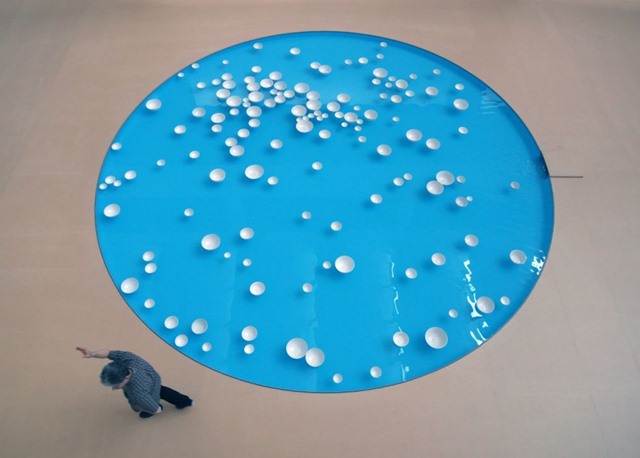Art & Exhibitions
Céleste Boursier-Mougenot Brings Motorized Trees to Venice Biennale
He deftly uses sound in installations that create a simple magic.

He deftly uses sound in installations that create a simple magic.

Brian Boucher


Céleste Boursier-Mougenot, rêvolutions, a project for the French Pavilion at the 56th Venice Biennale.
Courtesy of the artist and of Xippas, Paris; Paula Cooper Gallery, New York; Galerie Mario Mazzoli, Berlin. © Laurent Lecat.
French artist Céleste Boursier-Mougenot deftly uses sound in multi-medium installations that often create a simple magic.
Three projects now on view throughout Europe offer Boursier-Mougenot’s brand of enchantment, and though the artist doesn’t talk about them in this way, they sometimes chime in intriguing ways with challenging questions about science and current events.
Trained as a musician and composer, Boursier-Mougenot turned to visual art so that he could create sonic experiences with longer lives than those of concerts or theatrical productions.
At the Venice Biennial, Boursier-Mougenot represents France with a spellbinding presentation in the Giardini that has received too little notice in the press. Organized by curator Emma Lavigne, director of the Centre Pompidou-Metz, the work echoes at once with the mythical and with a strain of modern science.

Céleste Boursier-Mougenot, rêvolutions, a project for the French Pavilion at the 56th Venice Biennale.
Courtesy of the artist and of Xippas, Paris; Paula Cooper Gallery, New York; Galerie Mario Mazzoli, Berlin. © Laurent Lecat.
A large Scotch pine tree dominates the central room of the neoclassical French pavilion. It rests atop a hulking ball of dirt and roots, and, equipped with motors, it moves idly around the room, its movements resulting from a reading of electrical signals in the plants. A gentle electronic hum sounds in the space, its frequencies derived from the same signals. Two similar trees occupy the grounds, harmonizing with those that line the walkways between the national pavilions.
Boursier-Mougenot has a weakness for overly clever titles. Admittedly, maybe something is lost in translation, but this project is called rêvolutions, which combines the French word for dream, rêve, with révolutions to suggest, clunkily to my ear, a dream-revolution. (He dubbed from here to ear a work that turns an exhibition space into an aviary, as a flock of colorful finches perch on the amplified electric guitars and basses displayed so that their necks are horizontal, like tree branches.)
The artist had the glass removed from the pavilion’s skylights, rendering the interior open to the elements. When I arrived last weekend, it was just after a downpour, and the sun had re-emerged, so that the tree shimmered with the light on the rainwater as a few attendants mopped the floor.
The trees’ transformation recalls in reverse the myth of Apollo and Daphne. When the nymph Daphne appeals to her father, a god, to protect her from Apollo’s amorous advances, he turns her into a laurel tree. Lavigne further cites Francesco Colonna novel The Dream of Poliphilus and Primo Levi’s short story Dysphylaxis as literary parallels for the metamorphosis of trees. And for the artist, the trees’ movement in the space between the national pavilions symbolizes people’s free travel among countries, and has resonance with the movement of refugees.
However, the work has its most interesting resonance in a current debate among scientists about the very nature of plants.
In the last decade, some researchers have suggested that flora’s capacity to evaluate and respond to their environment can’t be convincingly explained by traditional models of adaptation. Some even suggest that plants are capable of cognition on some level. The model for so-called plant intelligence is something along the lines of that demonstrated by insect colonies, where a network of organisms undertakes directed action in ways no one member could plan.
“Roots about to encounter an impenetrable obstacle or a toxic substance change course before they make contact with it,” writes Michael Pollan in a recent review of plant science in The New Yorker. “Roots can tell whether nearby roots are self or other and, if other, kin or stranger.” One researcher has even shown that plants can learn, remarkably quickly, to ignore meaningless stimuli.
If it all seems like a stretch, there does seem to be something in the air. Artist Martin Roth created a work just this year, Untitled (Plant Concert), that allows plants to play music via a synthesizer that converts their electrical signals into music. Indonesia’s House of Natural Fiber performed music at New York’s New Museum in 2012 that was based on plant electrical signals, and Philadelphia record label Data Garden installed a work at the Philadelphia Museum of Art, also in 2012, in which visitors and plants created music together.
What if the capacity to learn and make rational decisions were shared not only by some animals but by plants too? Boursier-Mougenot’s project provides a lyrical emblem of such a notion.
Just as the project in the French pavilion is inspired partly by Italian Mannerist gardens, a new work in Paris at the Palais de Tokyo is inspired by floods that regularly come to Venice, covering sites like the St. Mark’s Square.

Exhibition view of Céleste Boursier-Mougenot, “acquaalta,” at the Palais de Tokyo, Paris.
Photo: Laurent Lecat. ADAGP, Paris 2015.
For his piece, Acquaalta, named for high water, Boursier-Mougenot has poured what must be thousands of gallons of water into a cavernous ground-floor gallery; visitors traverse the darkened space in simple gondola-style wooden boats, while ghostly figures, walking and mounting the same boats, are projected on the wall.
These are live projections, in fact, of the action in the gallery itself. An electronic hum is audible throughout, in this case generated by the video signals, translated into sound.

Exhibition view of Céleste Boursier-Mougenot, Acquaalta, at the Palais de Tokyo, Paris.
Photo: Laurent Lecat. ADAGP, Paris 2015.
Unfortunately, for all its spectacle, it doesn’t add up to the kind of mystical experience the artist was doubtless hoping for—certainly not on the opening night on Monday, when the space was inundated with young Parisians whose camera phones disrupted the atmosphere with constant flashes of light and glowing screens.
While Boursier-Mougenot stresses the project’s intention to create a space for reverie, it has darker implications. Water levels are rising as a result of global warming, with some scientists predicting that La Serenissima may be underwater in less than a century. St. Mark’s Square used to flood around 20 times a year; now it’s underwater three times as often.
If Boursier-Mougenot’s piece seems laden with nostalgia for the lagoons of Venice, it may be that soon enough, memories are all we’ll have left of the city.

Céleste Boursier-Mougenot, Untitled, 2011, PVC liner, pump, heating system, 100 porcelain bowls. In situ during the Marcel Duchamp prize exhibition, National Museum of Contemporary Art, Seoul, Korea, 2011.
Photo: Céleste Boursier- Mougenot. Courtesy Galerie Xippas.
Another project centered on water and sound is on view at the Centre Pompidou Metz, meanwhile, also courtesy of Lavigne. There, the artist is showing an adaptation of a piece that I saw at Paula Cooper Gallery in 1999 and that has remained in my memory for its simple means and winning charm.
clinamen involves a number of inflatable pools in which wine glasses and simple ceramic bowls are set afloat. They circulate in currents formed by small motors, and as they bump into one another, they fill the gallery with harmonious chiming. The acoustics are aided by heating elements, which warm the water.
Succeeding precisely where Acquaalta, with its elaborate means and limited payoff, falls short, clinamen employs the simplest of means to transform the gallery into a place of song.
The Venice Biennale is on view through November 22. acquaalta is on view at the Palais de Tokyo through September 13. clinamen v.2 is on view at the Centre Pompidou-Metz until September 28.